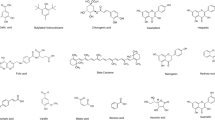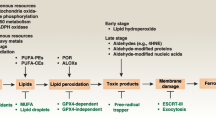Abstract
Endogenous fluorescence has been proposed as a means of aiding the diagnosis of various malignancies. It has been suggested that erythrocytes may be the carriers of fluorophors that accumulate in cancer tissue and may be useful in the diagnosis and treatment of malignancies. Hence, the present study was designed to explore the spectrofluorimetric analysis of blood components as a marker for the analysis of mammary carcinoma treatment and also to bring about the protective effect of the drug Semecarpus anacardium on oxidative stress mediated damage of erythrocytes. Fluorescence spectra of the blood components were studied and also the level of lipid per oxides and antioxidant enzymes status in erythrocytes were determined in DMBA induced mammary carcinoma rats treated with Semecarpus anacardium Linn nut milk extract. Fluorescence emission spectroscopy of blood components are altered under cancer conditions and the drug effectively ameliorated these alterations in mammary carcinoma induced rats. The drug also effectively reduced the oxidative stress induced erythrocyte damage thereby restoring the erythrocytes antioxidant status. These results suggest that erythrocytes may be the carriers of fluorophors that accumulate in cancer tissue and hence acts as new biomarkers for the diagnosis and treatment.




Similar content being viewed by others
References
Ferlay JBF, Pisani P, Parkin DM (2001) GLOBOCAN 2000: cancer incidence, mortality and prevalence worldwide, Version 1.0
Ferlay JSH, Bray F, Forman D, Mathers C, Parkin DM (2010) GLOBOCAN 2008 v1.2, Cancer incidence and + mortality worldwide: IARC cancer base no. 10
Agarwal G, Ramakant P (2008) Breast cancer care in India: the current scenario and the challenges for the future. Breast Care (Basel) 3:21–27
Agarwal G, Ramakant P, Forgach ER, Rendon JC, Chapparo JM, Basurto CS, Margaritoni M (2009) Breast cancer care in developing countries. World J Surg 33:2069–2076
Li DH, Wang MY, Dhingra K, Hittelman WN (1996) Aromatic DNA adducts in adjacent tissues of breast cancer patients: clues to breast cancer etiology. Cancer Res 56:287–293
Surveswaran S, Cai Y-Z, Corke H, Sun M (2007) Systematic evaluation of natural phenolic antioxidants from 133 Indian medicinal plants. Food Chem 102:938–953
Aravind SG, Arimboor R, Rangan M, Madhavan SN, Arumughan C (2008) Semi-preparative HPLC preparation and HPTLC quantification of tetrahydroamentoflavone as marker in Semecarpus anacardium and its polyherbal formulations. J Pharm Biomed Anal 48:808–813
Shin YG, Cordell GA, Dong Y, Pezzuto JM, Appa Rao AVN, Ramesh M, Ravi Kumar B, Radhakishan M (1999) Rapid identification of cytotoxic alkenyl catechols in Semecarpus anacardium using bioassay-linked high performance liquid chromatographyelectrospray/ mass spectrometric analysis. Phytochem Anal 10:208–212
Nair PKR, Melnick SJ, Wnuk SF, Rapp M, Escalon E, Ramachandran C (2009) Isolation and characterization of an anticancer catechol compound from Semecarpus anacardium. J Ethnopharmacol 122:450–456
Khan HBH, Vinayagam KS, Ashwini S, Palanivelu S, Panchanadham S (2011) Anti diabetic and antioxidant effect of Semecarpus anacardium in a high fat diet STZ induced Type 2 diabetic rat model. J Diet Suppl 1–5
Vinayagam KS, Khan HBH, Palanivelu S, Panchanadham S (2012) Hypolipidemic effect of Semecarpus anacardium Linn nut milk extract in high cholesterol fed hypercholesterolemic rats. Chin J Integr Med. doi:10.1007/s11655-012-1252-2
Subramaniam S, Khan HBH, Palanivelu S, Panchanadham S (2014) Antihyperlipidemic and antiinflammatory effect of Bhallataka nuts in ameliorating the alterations in lipid metabolsim and inflammation in diabetes induced cardiac damage in rats. Comp Clin Pathol. doi:10.1007/s00580-013-1828-z
Khan HBH, Vinayagam KS, Madan P, Palanivelu S, Panchanadham S (2012) Modulatory effect of Semecarpus anacardium against oxidative damages in DMBA induced mammary carcionogenesis rat model. Comp Clin Pathol 21(6):1275–1284
Dhanasekaran SM, Jaganathan R, Panchanadham S, Palanivelu S (2012) Induction of mitochondrial mediated apoptosis by Semecarpus anacardium in the BCR-ABL+ 12B1 leukemia cell line – a possible mechanism of therapeutic action in vivo. J Exp Clin Med 4(1):30–38
Mahadevan A, Mitchell MF, Silva E, Thomsen S, Richards-Kortum R (1993) Study of fluorescence properties of normal and neoplastic human cervical tissue. Lasers Surg Med 13:647–655
Ganesan S, Sacks PG, Yang Y, Katz A, Al-Rawi M, Schantz SP, Alfano RR (1998) Native fluorescence spectroscopy of normal and malignant epithelial cells. Cancer Biochem Biophys 16:365–373
Alfano RR, Tata DB, Cordero J, Tomashefsky P, Longo FW, Alfano MA (1984) Laser induced fluorescence spectroscopy from native cancerous and normal tissues. IEEE J Quantum Electron QE 20:1507–1510
Alfano RR, Tang GC, Pradhan A, Lam W, Choy DSJ, Opher E (1987) Fluorescence spectra from cancerous and normal human breast and lung tissues. IEEE J Quantum Electron QE 23:1507–1511
Kalaivani R, Masilamani V, Sivaji K, Elangovan M, Selvaraj V, Balamurugan SG, Al-Salhi MS (2008) Fluorescence spectra of blood components for breast cancer diagnosis. Photomed Laser Surg 26(3):251–256
Scot MD, Lubin BH, Zuo L, Kuypers FA (1991) Erythrocyte defense against hydrogen per- oxide. Preeminent importance of catalase. J Lab Clin Med 118:7–16
Abou-Ghalia AH, Found IM (2000) Glutathione and its metabolizing enzymes in patients with different benign and malignant diseases. Clin Biochem 33:657–662
Diplock AT (1991) Antioxidant nutrients and disease prevention:an overview. Am J Clin Nutr 53:189–193
Formulary of Siddha Medicine (1972) 2nd edn. Madras: Indian medicine practitioners Co-operative pharmacy and stores Ltd: 197
Welsch CW (1985) Factors affecting the growth of carcinogen induced mammary carcinomas. A review and tribute to Charles Brenton Huggins. Cancer Res 45:3415–3443
Sujatha V, Sachdanandam P (2002) Recuperative effect of Semecarpus anacardium Linn. nut milk extract on carbohydrate metabolizing enzymes in experimental mammary carcinoma-bearing rats. Phytother Res 16:14–18
Dodge JT, Mitchell C, Hanahan DJ (1963) The preparation and chemical characteristics of hemoglobin-free ghosts of human erythrocytes. Arch Biochem Biophys 100:119–130
Cynamon HA, Isenber JN, Nguyen C (1985) Erythrocyte malondialdehyde release invitro; a functional status in Vitamin E studies. Clin Chin Acta 15:169–176
Marklund S, Marklund G (1974) Involvement of the superoxide anion radical in the autoxidation of pyrogallol and a convenient assay for superoxide dismutase. Eur J Biochem 47:469–474
Sinha A (1972) Colorimetric assay of catalase. Anal Biochem 47:389–394
Rotruck JT, Pope AL, Ganther HE, Swanson AB, Hafeman DG, Hekstra WG (1973) Selenium, biochemical role as a component of glutathione peroxidase purification and assay. Science 179:588–590
Escrich E, Moral R, Garcá G, Costa I (2004) Identification of novel differentially expressed genes by the effect of a high-fat n-6 diet in experimental breast cancer. Mol Carcinog 40:73–78
Costa I, Solanas M, Escrich E (2002) Histopathologic characterization of mammary neoplastic lesions induced with 7, 12 dimethylbenz (alpha) anthracene in the rat: a comparative analysis with human breast tumours. Arch Pathol Lab Med 126:915–927
Jemal A, Bray F, Center MM, Ferlay J, Ward E, Forman D (2011) Global cancer statistics. CA Cancer J Clin 61:69–90
Karthikeyan K, Masilamani V, Govindasamy S (1999) Spectrofluorimetric detection of DMBA-induced mouse skin carcinoma. Pathol Oncol Res 5:46–49
Masilamani V, Sivakumar N, Anand KV (2003) Diagnosis of cancer from blood by native fluorescence. Asian J Phys 12:125–132
Leij-Halfwerk S, Dagnelie PC, van Den Berg JOW, Wattimena JD, Hordijk-Luijk CH, Wilson JP (2000) Weight loss and elevated gluconeogenesisfrom alanine in lung cancer patients. Am J Clin Nutr 71:583–589
Satyavati GV, Prasad DN, Das PK, Singh HD (1969) Anti inflammatory activity of Semecarpus anacardium Linn. A preliminary study. Ind. J Physiol Pharmacol 13:37
Abdi S, Ali A (1999) Role of oxygen free radicals in the pathogenesis and etiology of cancer. Cancer Lett 142:1–9
van Ginkel G, Sevanian A (1994) Lipid peroxidation induced membrane structural alterations. Methods Enzymol 233:273–288
Eritsland J (2000) Safety considerations of polyunsaturated fatty acids. Am J Clin Nutr 71:197S–201S
Rice-Evans C, Burdon R (1993) Free radical lipid interactions and their pathological consequences. Prog Lipid Res 32:71–110
Faber M, Coudray C, Hida H (1995) Lipid peroxidation products and vitamin E and trace element status in patients with cancer before and after chemotherapy including adriamycin. A preliminary study. Biol Trace Elem Res 47:117–123
Huang YL, Sheu JY, Lin TH (1999) Association between oxidative stress and changes of trace elements in patients with breast cancer. Clin Biochem 32:131–136
Chakraborty S, Roy M, Taraphdar AK, Bhattacharya RK (2004) Cytotoxic effect of root extract of Tiliacora racemosa and oil of Semecarpus anacardium nut in human tumour cells. Phytother Res 18(8):595–600
Venukumar MR, Latha MS (2002) Antioxidant effect of Coscinium fenestratum in hepatotoxin induced rats. Indian J Physiol Pharmacol 46(2):223–228
Micallef M, Lexis L, Lewandawski P (2007) Red wine consumption increases antioxidant status and decreases odidative stress in the circulation of both young and old humans. Nutr J 6:27
Garg S, Sharma K, Ranjan R, Attri P, Mishra P (2009) In vivo antioxidant activity and hepatoprotective effects of methanolic extract of Mesua ferrea linn. Int J Pharma Tech Res 1(4):1692–1696
de Góes Rocha FG, Chaves KCB, Gomes CZ, Campanharo CB, Courrol LC, Schor N, Bellini MH (2010) Erythrocyte protoporphyrin fluorescence as a biomarker for monitoring antiangiogenic cancer therapy. J Fluoresc 20:1225–1231
Balasubramanian S, Elangovan V, Govindasamy S (1995) Fluorescence spectroscopic identification of 7,12-dimethylbenz(a)anthracene induced hamster buccal pouch carcinogenesis. Carcinogenesis 16:2461–2465
Yang YL, Ye YM, Li FM, Li YF, Ma PZ (1987) Characteristic autofluorescence for cancer diagnosis and its origin. Lasers Surg Med 7:528–532
Miah MI (2001) Fluorescence spectroscopy study of protoporphyrin IX metabolism level in cells. Biopolymers 62:237–240
Chang KS, Ina P, Marin N, Follen M, Richards-Kortum R (2005) Fluorescence spectroscopy as a diagnostic tool for detecting cervical pre-cancer. Gynecol Oncol 99:S61–S63
Vogeser M, Jacob K, Zachoval R (2000) Erythrocyte protoporphyrins in hepatitis C viral infection. Clin Biochem 33(5):387–391
Courrol LC, Silva FRO, Coutinho EL, Piccoli MF, Mansano RD, Vieira ND, Schor N, Bellini MH (2007) Study of blood porphyrin spectral profile for diagnosis of tumor progression. J Fluoresc 17(3):289–292
Ramadan MF, Kinni SG, Seshagiri M, Mörsel J-T (2010) Fat-soluble bioactives, fatty acid profile and radical scavenging activity of semecarpus Anacardium seed oil. J Am Oil Chem Soc 87:885–894
Conflict of Interest
The authors declare that there is no conflict of interest among authors.
Author information
Authors and Affiliations
Corresponding author
Rights and permissions
About this article
Cite this article
Khan, H.B.H., Vani, S., Palanivelu, S. et al. Erythrocyte Protoporphyrin Fluorescence as a Biomarker to Monitor the Anticancer Effect of Semecarpus Anacardium in DMBA Induced Mammary Carcinoma Rat Model. J Fluoresc 25, 907–915 (2015). https://doi.org/10.1007/s10895-015-1571-8
Received:
Accepted:
Published:
Issue Date:
DOI: https://doi.org/10.1007/s10895-015-1571-8




